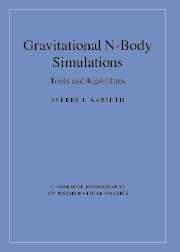Book contents
- Frontmatter
- Contents
- Preface
- 1 The N-body problem
- 2 Predictor–corrector methods
- 3 Neighbour treatments
- 4 Two-body regularization
- 5 Multiple regularization
- 6 Tree codes
- 7 Program organization
- 8 Initial setup
- 9 Decision-making
- 10 Neighbour schemes
- 11 Two-body algorithms
- 12 Chain procedures
- 13 Accuracy and performance
- 14 Practical aspects
- 15 Star clusters
- 16 Galaxies
- 17 Planetary systems
- 18 Small-N experiments
- Appendix A Global regularization algorithms
- Appendix B Chain algorithms
- Appendix C Higher-order systems
- Appendix D Practical algorithms
- Appendix E KS procedures with GRAPE
- Appendix F Alternative simulation method
- Appendix G Table of symbols
- Appendix H Hermite integration method
- References
- Index
10 - Neighbour schemes
Published online by Cambridge University Press: 18 August 2009
- Frontmatter
- Contents
- Preface
- 1 The N-body problem
- 2 Predictor–corrector methods
- 3 Neighbour treatments
- 4 Two-body regularization
- 5 Multiple regularization
- 6 Tree codes
- 7 Program organization
- 8 Initial setup
- 9 Decision-making
- 10 Neighbour schemes
- 11 Two-body algorithms
- 12 Chain procedures
- 13 Accuracy and performance
- 14 Practical aspects
- 15 Star clusters
- 16 Galaxies
- 17 Planetary systems
- 18 Small-N experiments
- Appendix A Global regularization algorithms
- Appendix B Chain algorithms
- Appendix C Higher-order systems
- Appendix D Practical algorithms
- Appendix E KS procedures with GRAPE
- Appendix F Alternative simulation method
- Appendix G Table of symbols
- Appendix H Hermite integration method
- References
- Index
Summary
Introduction
Direct N-body simulations on conventional computers benefit greatly from the use of the Ahmad–Cohen [1973] or AC neighbour scheme. Algorithms for both the divided difference method and Hermite formulation will therefore be discussed in the following sections. We also consider the implementation of the code N BODY6++ on a popular type of parallel computer [Spurzem, Baumgardt & Ibold, 2003], since it seems that the future of large-N calculations is evolving in this direction at least for those who do not use the special-purpose HARP or GRAPE machines described previously. The important problem of massive black hole binaries in galactic nuclei is very challenging and appears amenable to direct integration using parallel architecture and neighbour schemes. A direct solution method is described [Milosavljević & Merritt, 2001]. This treats the massive components by two-body regularization, whereas the formation process itself is studied by a tree code. Some of the drawbacks of this method inspired a new formulation where the massive binary is considered as part of a compact subsystem which is advanced by a time-transformed leapfrog method [Mikkola & Aarseth, 2002]. Over the years, the quest for larger particle numbers has also encouraged the construction of partially collisional methods.
- Type
- Chapter
- Information
- Gravitational N-Body SimulationsTools and Algorithms, pp. 164 - 180Publisher: Cambridge University PressPrint publication year: 2003



